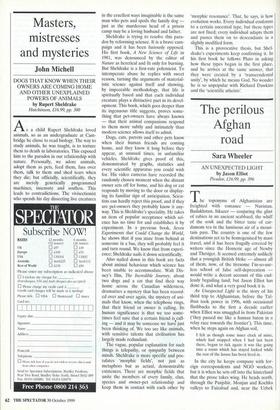Masters, mistresses and mysteries
John Michell
DOGS THAT KNOW WHEN THEIR OWNERS ARE COMING HOME AND OTHER UNEXPLAINED POWERS OF ANIMALS by Rupert Sheldrake Hutchinson, £16.99, pp. 300
s a child Rupert Sheldrake loved animals, so as an undergraduate at Cam- bridge he chose to read biology. The way to study animals, he was taught, is to torture them to death in laboratories. This exposed him to the paradox in our relationship with nature. Personally, we adore animals, adopt them as pets, feed them, fuss over them, talk to them and shed tears when they die; but officially, scientifically, they are merely genetically programmed machines, insensate and soulless. This eads to contradictions. The vivisectionist who spends his day dissecting live creatures
in the cruellest ways imaginable is the same man who pets and spoils the family dog just as the murderous head of a prison camp may be a loving husband and father.
Sheldrake is trying to resolve this para- dox by reforming science. It is a brave cam- paign and it has been furiously opposed. His first book, A New Science of Life in 1981, was denounced by the editor of Nature as heretical and fit only for burning. But Sheldrake is a first-rate polemicist. To intemperate abuse he replies with sweet reason, turning the arguments of material- istic science against itself and showing, by impeccable methodology, that life is spiritually based and that each individual creature plays a distinctive part in its devel- opment. This book, which goes deeper than its ingenuous title suggests, proves some- thing that pet-owners have always known — that their animal companions respond to them more subtly and intimately than modern science allows itself to admit.
Dogs, cats, parrots and other pets know when their human friends are coming home, and they know it long before they appear, at unusual times, in unfamiliar vehicles. Sheldrake gives proof of this, demonstrated by graphs, statistics and every scientific apparatus you could wish for. His video cameras have recorded the randomly chosen moment when the distant owner sets off for home, and his dog or cat responds by moving to the door or display- ing its familiar sign of anticipation. Scien- tists can hardly reject this proof, and if they are pet-owners they probably know it any- way. This is Sheldrake's speciality. He takes an item of popular acceptance which sci- ence has no time for and establishes it by experiment. In a previous book, Seven Experiments that Could Change the World, he shows that if you stare from behind at someone in a bus, they will probably feel it and turn round, We know that from experi- ence; Sheldrake nails it down scientifically.
Also nailed down in this book are facts about animal behaviour which science has been unable to accommodate. Walt Dis- ney's film, The Incredible Journey, about two dogs and a cat that find their way home across the Canadian wilderness, dramatises a mystery that has been record- ed over and over again, the mystery of ani- mals that know, when the telephone rings, that their friend or owner is calling. Its human significance is that we too some- times feel sure that a certain friend is.call- ing — and it may be someone we have just been thinking of. We too are like animals, with sensitive talents that civilisation has largely made redundant.
The vague, popular explanation for such things is telepathy, or sympathy between minds. Sheldrake is more specific and pos- tulates `morphic fields', not just as metaphors but as actual, demonstrable existences, There are morphic fields that unite the members of every family, clan, species and owner-pet relationship and keep them in contact with each other by
'morphic resonance'. That, he says, is how evolution works. Every individual conforms to a certain ancestral type, but these types are not fixed; every individual adapts them and passes them on to descendants in a slightly modified form.
This is a provocative thesis, but Shel- drake's experiments keep confirming it. In his first book he follows Plato in asking how these types began in the first place, and he arrives at the same answer, that they were created by a 'transcendental unity', by which he means God. No wonder he is so unpopular with Richard Dawkins and the 'scientific atheists'.


























































































 Previous page
Previous page